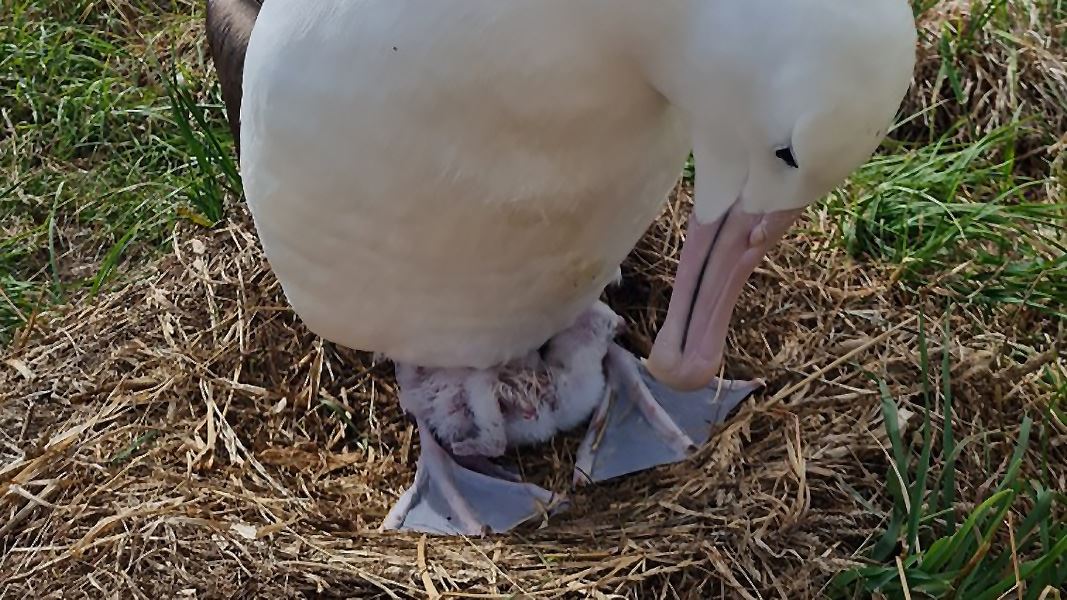Archived content: This media release was accurate on the date of publication.
Date: 26 January 2021
The Royal Cam chick hatched in the incubator and was returned to the nest under its dad LGK on Sunday evening.
Get a first look at the royal albatross hatchling In the nest
So far, 16 chicks have hatched from a bumper breeding season of 41 eggs, 36 of which were viable – the second highest number recorded in the more than 80 years the colony has been at the head.
DOC Ranger Sharyn Broni says the Royal Cam chick, weighing in at 280 grams on Monday morning, is healthy.
“With the Royal Cam chick back in the nest, it’s a great time to tune into the livestream, to watch the toroa grow to adulthood and learn about the work that goes into protecting these special birds.”
She says people can help the toroa by cleaning up at beaches to reduce the plastic in the ocean that albatross can mistake for food. People can also take steps to reduce the effects of climate change, as studies suggest warmer seas may make it harder for toroa to find food.
“It’s a busy time for the rangers at the colony, with staff on site 12 hours a day, seven days a week to give these chicks the best possible chance of survival.
“The bulk of the eggs were laid early in the season and are now hatching within a few days of each other, with more than a dozen currently hatching in the two incubators.”
Sharyn says it is still a risky time for newly-hatched chicks as they need to be monitored for flystrike and to make sure their first feed from their parents goes smoothly.
“We’re keeping an eye on the hot weather forecast for later in the week and will be using the irrigation system as necessary to make sure the toroa stay cool.”
Royal Albatross Centre Operations Manager Chris McCormack says “this is a special time of year with new toroa life coming to Pukekura, and a great time for visitors to visit the colony as there are several nests within view of the observatory. We are hoping for cool weather to assist the albatross chicks this summer.”
This is the third time Royal Cam parents LGK and LGL (named for the colours of the bands on their legs) have attempted to breed since they got together in 2017. They were the focus of Royal Cam in the 2019 season, when they successfully raised their chick Karere.
Last season (December 2019 to September 2020), the livestream received more than 2.5 million views globally and was watched for 584,033 hours. The livestream is run with the support of New York University’s Cornell Lab of Ornithology, which partnered with the programme in 2019 and significantly boosted its reach internationally.
More about Royal Cam
Royal Cam is a livestream of the toroa/northern royal albatross colony at Pukekura/Taiaroa Head, on the Otago Peninsula. The colony is the only mainland place in the world to view northern royal albatross in their natural habitat. Each year, the livestream focuses on one breeding pair as they raise a chick to fledge (leave the headland).
Toroa/northern royal albatross are one of the largest seabirds in the world, with wingspans up to 3m. They are a vulnerable species that has been affected by changes to habitat and climate and by some fishing practices.
They also reproduce slowly, with breeding pairs typically raising a chick once every two years.
The Royal Cam egg was laid on November 7, and since then Royal Cam stars LGK and LGL have been taking turns to keep it warm while the other spent up to two weeks at sea feeding.
Once an egg pips (when the chick punches a small hole in the eggshell to start the process of hatching), it is swapped with a dummy and taken to an incubator to prevent flystrike. This is when flies lay maggots on the egg or chick, which can quickly kill it, during the three to six day hatching process.
The parents will be in the guard stage for the next five or six weeks, meaning one will stay at the nest while the other spends a few days hunting for food. After that, they will leave the chick unguarded, except for feeding visits, until it fledges in spring.
DOC manages the albatross colony with the support of the Otago Peninsula Trust, Te Poari a Pukekura (Pukekura Co-management Trust, which governs Pukekura/Taiaroa Head) and Dunedin City Council. It has grown from one breeding pair in 1937 to more than 60 pairs in 2020.
Royal Cam joined Cornell Lab’s global network of live bird cameras in 2019, upgrading DOC’s existing web so the stream now features new capabilities like the ability to pan and night vision. Night vision also gives our international streamers the ability to tune in at any time of the day, when previously they would miss out on much of the albatross action due to different time zones.
Pukekura/Taiaroa Head is a significant site for its cultural and historic values, and for the other taonga species that live there. It is home to about 10,000 birds including red-billed gulls, little penguins, spotted shags, Otago shags, titi, and royal spoonbill.
Contact
For media enquiries contact:
Email: media@doc.govt.nz
